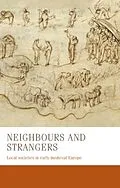This book explores social cohesion in rural settlements in western Europe from 700-1050, asking to what extent settlements, or districts, constituted units of social organisation. It focuses on the interactions, interconnections and networks of people who lived side by side - neighbours. Drawing evidence from most of the current western European countries, the book plots and interrogates the very different practices of this wide range of regions in a systematically comparative framework. It considers the variety of local responses to the supra-local agents of landlords and rulers and the impact, such as it was, of those agents on the small-scale residential group. It also assesses the impact on local societies of the values, instructions and demands of the wider literate world of Christianity, as delivered by local priests.
Autorentext
Bernhard Zeller is Senior Research Fellow at the Institute for Medieval Research of the Austrian Academy of Sciences, Austria; Charles West is Reader in Medieval History in the Department of History at the University of Sheffield, UK; Francesca Tinti is Ikerbasque Research Professor in the Department of Medieval, Modern and American History at the University of the Basque Country UPV/EHU, Spain; Marco Stoffella is Research Fellow and Adjunct Professor in Medieval History at the University of Verona, Italy; Nicolas Schroeder is Assistant Professor in Medieval History at the Université libre de Bruxelles, Belgium; Carine van Rhijn is Lecturer in the Department of History and Art History at the University of Utrecht, Netherlands; Steffen Patzold is Professor of Medieval History in the Department of History at the University of Tübingen, Germany; Thomas Kohl is Acting Professor in the Department of History at the University of Tübingen, Germany; Wendy Davies is Professor Emerita of History at University College London and Associate Member in the Faculty of History at the University of Oxford, UK; Miriam Czock is Senior lecturer in the History Department at the University of Duisburg-Essen, Germany
Klappentext
Neighbours and strangers investigates social cohesion in rural settlements in western Europe from 700 to 1050, asking to what extent settlements, or districts, constituted units of social organisation. It focuses on the interactions, interconnections and networks of people who lived side by side neighbours.The book offers a new approach to well-known problems of the early Middle Ages by bringing together expertise in different regions from different national traditions in a comparative framework. It discusses the basic constituents of early medieval rural societies: material dimensions, such as settlement, topography and the appropriation of resources, as well as fundamental factors that define the position of individuals within local societies and groups, such as legal status and socio-economic stratification. It examines how people in the early medieval west worked together in pursuit of shared goals beyond the level of the household, and how (and whether) they formed their own groups through that collective action.The book also explores the position of early medieval priests and their capacity to stimulate social cohesion in local communities. Finally, it treats the ways in which outside authorities, office holders from both the public and the private sphere and political elites, intervened in local society.
Inhalt
1 Questions to pursue2 Setting the scene3 The fabric of local societies: people, land and settlement4 Making groups: collective action in rural settlements5 Shepherds, uncles, owners, scribes: priests as neighbours in early medieval local societies6 Interventions in local societies: lower office holders7 Interventions and interactions8 Neighbours, visitors and strangers: searching for the localIndex
